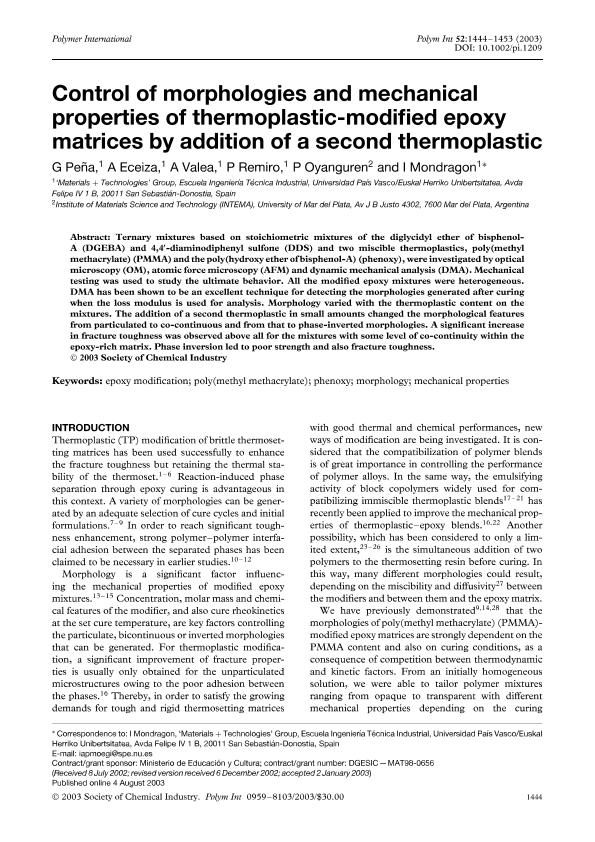Mostrar el registro sencillo del ítem
dc.contributor.author
Peña, G.
dc.contributor.author
Eceiza, A.
dc.contributor.author
Valea, A.
dc.contributor.author
Remiro, P.
dc.contributor.author
Oyanguren, Patricia Angelica

dc.contributor.author
Mondragon, I.
dc.date.available
2019-05-28T16:18:07Z
dc.date.issued
2003-09
dc.identifier.citation
Peña, G.; Eceiza, A.; Valea, A.; Remiro, P.; Oyanguren, Patricia Angelica; et al.; Control of morphologies and mechanical properties of thermoplastic-modified epoxy matrices by addition of a second thermoplastic; John Wiley & Sons Ltd; Polymer International; 52; 9; 9-2003; 1444-1453
dc.identifier.issn
0959-8103
dc.identifier.uri
http://hdl.handle.net/11336/77322
dc.description.abstract
Ternary mixtures based on stoichiometric mixtures of the diglycidyl ether of bisphenol-A (DGEBA) and 4,4′-diaminodiphenyl sulfone (DDS) and two miscible thermoplastics, poly(methyl methacrylate) (PMMA) and the poly(hydroxy ether of bisphenol-A) (phenoxy), were investigated by optical microscopy (OM), atomic force microscopy (AFM) and dynamic mechanical analysis (DMA). Mechanical testing was used to study the ultimate behavior. All the modified epoxy mixtures were heterogeneous. DMA has been shown to be an excellent technique for detecting the morphologies generated after curing when the loss modulus is used for analysis. Morphology varied with the thermoplastic content on the mixtures. The addition of a second thermoplastic in small amounts changed the morphological features from particulated to co-continuous and from that to phase-inverted morphologies. A significant increase in fracture toughness was observed above all for the mixtures with some level of co-continuity within the epoxy-rich matrix. Phase inversion led to poor strength and also fracture toughness.
dc.format
application/pdf
dc.language.iso
eng
dc.publisher
John Wiley & Sons Ltd

dc.rights
info:eu-repo/semantics/openAccess
dc.rights.uri
https://creativecommons.org/licenses/by-nc-sa/2.5/ar/
dc.subject
Epoxy Modification
dc.subject
Mechanical Properties
dc.subject
Morphology
dc.subject
Phenoxy
dc.subject
Poly(Methyl Methacrylate)
dc.subject.classification
Otras Ingeniería Química

dc.subject.classification
Ingeniería Química

dc.subject.classification
INGENIERÍAS Y TECNOLOGÍAS

dc.title
Control of morphologies and mechanical properties of thermoplastic-modified epoxy matrices by addition of a second thermoplastic
dc.type
info:eu-repo/semantics/article
dc.type
info:ar-repo/semantics/artículo
dc.type
info:eu-repo/semantics/publishedVersion
dc.date.updated
2019-05-15T16:44:55Z
dc.journal.volume
52
dc.journal.number
9
dc.journal.pagination
1444-1453
dc.journal.pais
Reino Unido

dc.journal.ciudad
Londres
dc.description.fil
Fil: Peña, G.. Universidad del País Vasco; España
dc.description.fil
Fil: Eceiza, A.. Universidad del País Vasco; España
dc.description.fil
Fil: Valea, A.. Universidad del País Vasco; España
dc.description.fil
Fil: Remiro, P.. Universidad del País Vasco; España
dc.description.fil
Fil: Oyanguren, Patricia Angelica. Consejo Nacional de Investigaciones Científicas y Técnicas. Centro Científico Tecnológico Conicet - Mar del Plata. Instituto de Investigaciones en Ciencia y Tecnología de Materiales. Universidad Nacional de Mar del Plata. Facultad de Ingeniería. Instituto de Investigaciones en Ciencia y Tecnología de Materiales; Argentina
dc.description.fil
Fil: Mondragon, I.. Universidad del País Vasco; España
dc.journal.title
Polymer International

dc.relation.alternativeid
info:eu-repo/semantics/altIdentifier/url/https://onlinelibrary.wiley.com/doi/abs/10.1002/pi.1209
dc.relation.alternativeid
info:eu-repo/semantics/altIdentifier/doi/http://dx.doi.org/10.1002/pi.1209
Archivos asociados
